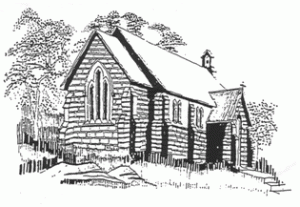St John the evangelist Hartley
This historic church in an historic village, has been in use for over 150 years
The Building History of St John the Evangelist, Hartley
 Edmund T Blacket, designed the church for Hartley and an unidentified foundation stone was laid by Bishop Frederick Barker on 21 April 1858. The church was opened and dedicated on 27 February 1859, again by Bishop Barker. The ‘Early English’ stone church was built without Blacket’s supervision and accordingly was very simple in design. The paired lancets on each bay of the nave have no mouldings and the stepped buttresses and western bell-cote were standard in the 1850s. The only external decoration was a simple moulded strong stone course below the windows and a hood mould over the east window.
Edmund T Blacket, designed the church for Hartley and an unidentified foundation stone was laid by Bishop Frederick Barker on 21 April 1858. The church was opened and dedicated on 27 February 1859, again by Bishop Barker. The ‘Early English’ stone church was built without Blacket’s supervision and accordingly was very simple in design. The paired lancets on each bay of the nave have no mouldings and the stepped buttresses and western bell-cote were standard in the 1850s. The only external decoration was a simple moulded strong stone course below the windows and a hood mould over the east window.
St John’s interior is simple with a plain chancel dividing nave from sanctuary. The entrance to the church was originally to be on the north side but this was closed due to severe westerly winds and the entrance, without a porch, made though the second bay opposite the south wall of the nave. St John’s is now within the boundaries of the Hartley National Parks and Wildlife Services Hartley Village Historic Site and belongs to the Parish of Blackheath.
Anglican history in the Hartley Valley
The first Anglican Church service was held at Glenroy, Hartley on 30 April 1815, the occasion of Governor Macquarie’s trip over the Blue Mountains to mark the completion of the first road. Services continued to be held from time to time in private homes and places such as Collits’ Inn. Thomas Hassell, son of a CMS missionary and one of the founders of the Sunday School movement in Australia, took a service in the Court House on 24 March 1839. The nearest ‘Church of England’ was Holy Trinity at Kelso (Bathurst) whose minister went to Hartley to take services. In 1857 the Reverend John Troughton was appointed to be in charge of the new Parish of Hartley. The church was built through his leadership at the cost of one thousand, three hundred and fifty six pounds. The new building was opened and dedicated by the Bishop of Sydney and Metropolitan, Bishop Barker, on 27 February 1859, before a large gathering of residents. The Reverend John Troughton was the first rector, but his ministry was cut short when he lost his life on 23 December that same year by drowning in a stream during the course of his parochial visitations. St John’s more evangelical beginnings are evidenced in the stained glass windows lacking any human representations. The Church was developed by ministers concerned to preach the gospel to the soldiers and convicts, as well as farmers and travellers, who frequented the town.
At first the church came under the rector of Kelso, and then for some years under the rector of Littleton (near Lithgow). In 1997 it was transferred to the Parish of Blackheath, which has pastoral oversight to the present day.
Ministers with pastoral oversight for the church since its dedication have been:
Rev J Troughton 1857 – 1859
Rev W Coombs 1860 – 1865
Rev R H Mayne 1865- 1886
Rev J Hornby-Spear 1886- 1892
Rev T J Heffernan 1892 – 1925
Rev W P Dorph 1925 – 1957
Rev E O Harding 1958 – 1959
Rev C J Letts 1960 – 1062
Rev H R J Scott 1962 – 1964
Rev G A Taylor 1965
Rev H L Robertson 1965 – 1967
Rev H R Voss 1967 – 1969
Rev N Mathieson 1969 – 1971
Rev R R McKinney 1971 – 1975
Rev R Buckingham 1975 – 1978
Rev F W Mostyn 1978 – 1981
Rev D J I Steele 1982 – 1996
Rev D H White 1997 -2002
Rev I R Mears 2002 – 2006
Rev E J Hughes (locum) 2006 -2007
Rev P A Bassett (locum) 2007 – 2008
Rev J H Gaunt 2008 – 2014
Rev T McIver 2014 –
Hartley
WE MEET WEEKLY AT
08:45AM
St Peter’s Mt Victoria
10:30AM
St Aidan’s Blackheath
and monthly at
1st Sunday at 5pm
St John’s Hartley
2st Sunday at 3pm
St George’s Mt Wilson
All services are followed by a time of fellowship and refreshments
